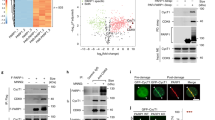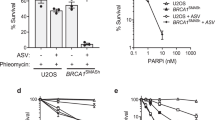Abstract
Poly(ADP-ribose) polymerase 1 (PARP-1) and p53 are two key proteins in the DNA-damage response. Although PARP-1 is known to poly(ADP-ribosyl)ate p53, the role of this modification remains elusive. Here, we identify the major poly(ADP-ribosyl)ated sites of p53 by PARP-1 and find that PARP-1-mediated poly(ADP-ribosyl)ation blocks the interaction between p53 and the nuclear export receptor Crm1, resulting in nuclear accumulation of p53. These findings molecularly link PARP-1 and p53 in the DNA-damage response, providing the mechanism for how p53 accumulates in the nucleus in response to DNA damage. PARP-1 becomes super-activated by binding to damaged DNA, which in turn poly(ADP-ribosyl)ates p53. The nuclear export machinery is unable to target poly(ADP-ribosyl)ated p53, promoting accumulation of p53 in the nucleus where p53 exerts its transactivational function.
This is a preview of subscription content, access via your institution
Access options
Subscribe to this journal
Receive 12 print issues and online access
$209.00 per year
only $17.42 per issue
Buy this article
- Purchase on Springer Link
- Instant access to full article PDF
Prices may be subject to local taxes which are calculated during checkout





Similar content being viewed by others
References
Vousden, K. H. Activation of the p53 tumor suppressor protein. Biochim. Biophys. Acta 1602, 47–59 (2002).
Gottifredi, V. & Prives, C. The S phase checkpoint: when the crowd meets at the fork. Semin. Cell Dev. Biol. 16, 355–368 (2005).
Bode, A. M. & Dong, Z. Post-translational modification of p53 in tumorigenesis. Nature Rev. Cancer 4, 793–805 (2004).
Herceg, Z. & Wang, Z.-Q. Functions of poly(ADP-ribose) polymerase (PARP) in DNA repair, genomic integrity and cell death. Mutat. Res. 477, 97–110 (2001).
Bürkle, A. Poly(ADP-ribosyl)ation, a DNA damage-driven protein modification and regulator of genomic instability. Cancer Lett. 163, 1–5 (2001).
Wesierska-Gadek, J., Schmid, G. & Cerni, C. ADP-ribosylation of wild-type p53 in vitro: binding of p53 protein to specific p53 consensus sequence prevents its modification. Biochem. Biophys. Res. Commun. 224, 96–102 (1996).
Mendoza-Alvarez, H. & Alvarez-Gonzalez, R. Regulation of p53 sequence-specific DNA-binding by covalent poly(ADP-ribosyl)ation. J. Biol. Chem. 276, 36425–36430 (2001).
Simbulan-Rosenthal, C. M., Rosenthal, D. S., Luo, R. & Smulson, M. E. Poly(ADP-ribosyl)ation of p53 during apoptosis in human osteosarcoma cells. Cancer Res. 59, 2190–2194 (1999).
Kanai, M., Tong, W.-M., Sugihara, E., Wang, Z.-Q., Fukasawa, K. & Miwa, M. Involvement of poly(ADP-ribose) polymerase 1 and poly(ADP-ribosyl)ation in regulation of centrosome function. Mol. Cell. Biol. 23, 2451–2462 (2003).
Vaziri, H. et al. ATM-dependent telomere loss in aging human diploid fibroblasts and DNA damage lead to the post-translational activation of p53 protein involving poly(ADP-ribose) polymerase. EMBO J. 16, 6018–6033 (1997).
Valenzuela, M. T. et al. PARP-1 modifies the effectiveness of p53-mediated DNA damage response. Oncogene 21, 1108–1116 (2002).
Wieler, S., Gagné, J., Vaziri, H., Poirier, G. G. & Benchimol, S. Poly(ADP-ribose) polymerase-1 is a positive regulator of the p53-mediated G1 arrest response following ionizing radiation. J. Biol. Chem. 278, 18914–18921 (2003).
Agarwal, M. L., Agarwal, A., Taylor, W. R., Wang, Z.-Q., Wagner, E. F. & Stark, G. R. Defective induction but normal activation and function of p53 in mouse cells lacking poly-ADP-ribose polymerase. Oncogene 15, 1035–1041 (1997).
Michael, D. & Oren, M. The p53–Mdm2 module and the ubiquitin system. Semin. Cancer Biol. 13, 49–58 (2003).
Freedman, D. A. & Levine, A. J. Nuclear export is required for degradation of endogenous p53 by MDM2 and human papillomavirus E6. Mol. Cell. Biol. 18, 7288–7293 (1998).
Lain, S., Midgley, C., Sparks, A., Lane, E. B. & Lane, D. P. An inhibitor of nuclear export activates the p53 response and induces the localization of HDM2 and p53 to U1A-positive nuclear bodies associated with the PODs. Exp. Cell Res. 248, 457–472 (1999).
Lohrum, M. A., Woods, D. B., Ludwig, R. L., Balint, E. & Vousden, K. H. C-terminal ubiquitination of p53 contributes to nuclear export. Mol. Cell. Biol. 21, 8521–8532 (2001).
Zhang, Y. & Xiong, Y. A p53 amino-terminal nuclear export signal inhibited by DNA damage-induced phosphorylation. Science 292, 1910–1915 (2001).
Stommel, J. M., Marchenko, N. D., Jimenez, G. S., Moll, U. M., Hope, T. J. & Wahl, G. M. A leucine-rich nuclear export signal in the p53 tetramerization domain: regulation of subcellular localization and p53 activity by NES masking. EMBO J. 18, 1660–1672 (1999).
Wesierska-Gadek, J., Wojciechowski, J. & Schmid, G. Central and carboxy-terminal regions of human p53 protein are essential for interaction and complex formation with PARP-1. J. Cell Biochem. 89, 220–232 (2003).
Lu, W., Pochampally, R., Chen, L., Traidej, M., Wang, Y. & Chen, J. Nuclear exclusion of p53 in a subset of tumors requires MDM2 function. Oncogene 19, 232–240 (2000).
Geyer, R. K., Yu, Z. K. & Maki, C. G. The MDM2 RING-finger domain is required to promote p53 nuclear export. Nature Cell Biol. 2, 569–573 (2000).
Boyd, S. D., Tsai, K. Y. & Jacks, T. An intact HDM2 RING-finger domain is required for nuclear exclusion of p53. Nature Cell Biol. 2, 563–568 (2000).
Haupt, Y., Maya, R., Kazaz, A. & Oren, M. Mdm2 promotes the rapid degradation of p53. Nature 387, 296–299 (1997).
Kubbutat, M. H., Jones, S. N. & Vousden, K. Regulation of p53 stability by MDM2. Nature 387, 299–303 (1997).
Inoue, T., Wu, L., Stuart, J. & Maki, C. G. Control of p53 nuclear accumulation in stressed cells. FEBS Lett. 579, 4978–4984 (2005).
Wesierska-Gadek, J. & Schmid, G. Poly(ADP-ribose) polymerase-1 regulates the stability of the wild-type p53 protein. Cell. Mol. Biol. Lett. 6, 117–140 (2001).
Lu, W., Chen, L., Peng, Y. & Chen, J. Activation of p53 by roscovitine-mediated suppression of MDM2 expression. Oncogene 20, 3206–3216 (2001).
Sherr, C. J. Divorcing ARF and p53: an unsettled case. Nature Rev. Cancer 6, 663–673 (2006).
Simbulan-Rosenthal, C. M., Rosenthal, D. S., Ding, R., Bhatia, K. & Smulson, M. E. Prolongation of the p53 response to DNA strand breaks in cells depleted of PARP by antisense RNA expression. Biochem. Biophys. Res. Commun. 253, 864–868 (1998).
Moll, U. M., Wolff, S., Speidel, D. & Deppert, W. Transcription-independent pro-apoptotic functions of p53. Curr. Opin. Cell Biol. 17, 631–636 (2005).
Tewari, M. et al. Yama/CPP32 beta, a mammalian homolog of CED-3, is a CrmA-inhibitable protease that cleaves the death substrate poly(ADP-ribose) polymerase. Cell 81, 801–809 (1995).
Malanga, M., Pleschke, J. M., Kleczkowska, H. E. & Althaus, F. R. Poly(ADP-ribose) binds to specific domains of p53 and alters its DNA binding functions. J. Biol. Chem. 273, 11839–11843 (1998).
Kraus, W. L. & Lis, J. T. PARP goes transcription. Cell 113, 677–683 (2003).
Acknowledgements
We thank E. Kuroishi, S. Takano, and C. French for technical assistance. We also thank Z.-Q. Wang for PARP-1+/+ and PARP-1−/− MEFs, and X. Wang for the Crm1 plasmids. This research was supported by National Institute of Health (HL072889 to A.H.B, and CA90522 and CA95925 to K.F.).
Author information
Authors and Affiliations
Corresponding author
Ethics declarations
Competing interests
The authors declare no competing financial interests.
Supplementary information
Supplementary Title
Supplementary Figures S1, S2, S3, S4, S5 and S6 (PDF 435 kb)
Rights and permissions
About this article
Cite this article
Kanai, M., Hanashiro, K., Kim, SH. et al. Inhibition of Crm1–p53 interaction and nuclear export of p53 by poly(ADP-ribosyl)ation. Nat Cell Biol 9, 1175–1183 (2007). https://doi.org/10.1038/ncb1638
Received:
Accepted:
Published:
Issue Date:
DOI: https://doi.org/10.1038/ncb1638
This article is cited by
-
RBM47 restrains renal cell carcinoma progression and chemoresistance through interacting with lncRNA HOXB-AS1
Cell Death Discovery (2023)
-
C9orf72 functions in the nucleus to regulate DNA damage repair
Cell Death & Differentiation (2023)
-
GmPARPs differentially regulate the drought and heat stress tolerance in soybean
Plant Growth Regulation (2023)
-
Poly(ADP-ribosyl)ation of acetyltransferase NAT10 by PARP1 is required for its nucleoplasmic translocation and function in response to DNA damage
Cell Communication and Signaling (2022)
-
p53 at the crossroad of DNA replication and ribosome biogenesis stress pathways
Cell Death & Differentiation (2022)



